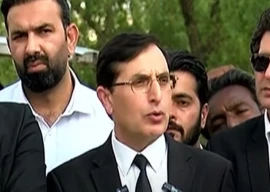
At first glance, the 139-year-old Masjid Rajgan of Khanpur Valley is still powerful in its historical and architectural expression but, at the same time, neglect is evident in its eroding structure.
What isn’t visible to the bare eye is the dedication Raja Sultan Jehandad Khan put into building the once magnificent mosque in the 19th century.
Masjid Rajgan, famous for its name, was built in 1872 by Raja Sultan Jehandad Khan, the grandfather of senior parliamentarian and former Chief Minister of NWFP the late Raja Sikandar Zaman Khan. Raja Sultan Jehandad was also the founder of old Khanpur Town, which was later inundated by the Khanpur Lake, forcing its population to resettle in new Khanpur and other adjoining areas in the late 70s.
According to local elders, as well as his family members, Jehandad Khan invited architects of Islamic Art from Dehli to construct the mosque in the valley.
The architects used bricks and beautifully chiseled black stones to construct the mosque, locals said. Wood, used for doors, cupboards and the roof, was imported from Leepa Valley. The historic mosque, a symbol of old Islamic architecture, has two big and two small minarets, with a dome-shaped small minaret mounted in the centre.
Four of the mosque’s arched entrances and the main gate are replicas of the Jamia Masjid in New Dehli, which was built by Emperor Shah Jehan in 1650-1656 AD.
According to the elders, the chiseled black stone used to construct the main boundary wall of Rajgan Masjid was imported from India. Some, however, believe it was local stone from old Taxila city.
The mosque, built with the capacity of accommodating about 1, 000 worshippers, now stands abandoned, with its walls crumbling with each passing day.
Raja Sheeraz Haider, a local PML-N leader and the great grandson of Jehandad Khan said that when the Khanpur Dam was built in the late 70s, his family along with other residents migrated to present-day Khanpur leaving behind the mosque and their family’s palace.
The palace was, also, in itself an architectural site. It was also built with chiseled stone and wood from Leepa Valley. Belgium glass was used for the windows and in cupboards, tiles were imported from Italy and door knobs were from France.
Haider said that the palace cost a total of Rs1.2 million in 1872, and took 10 years to complete. Unfortunately, he added, when they were asked to relocate, Wapda authorities paid only Rs900,000 as ‘compensation’ against property loss. He further claimed that in 2000 the palace was destroyed by Wapda authorities and its valuable fixtures, including carved wooden doors, chiseled stone and imported tiles, were seized.
The demolition of his family’s palace was in violation of the Antiquities Act laws, Haider said, adding that Wapda officials were liable to punishment.
Although Masjid Rajgan stands erect, lack of maintenance and the indifference of authorities are making sure it’s on its way to extinction.
The mosque is surrounded by water through July and September when the Khanpur Lake is filled to the maximum conservation level. Such damp conditions have been least favourable for the structure, which has been left at the mercy of the weather.
The mosque’s beautiful, carved wooden doors have been stolen, making it a comfortable abode for stray animals.
Under the Antiquities Act 1975, the mosque qualifies as being declared a preserved antique by the department of archeology. However, despite devolution of the archeology department to the province, the department has not taken any steps to rehabilitate the ruined structure of the mosque or declare it an archeological monument.
Published in The Express Tribune, December 15th, 2011.
COMMENTS (1)
Comments are moderated and generally will be posted if they are on-topic and not abusive.
For more information, please see our Comments FAQ












































What a pity!! No wonder ninety percent of archaeological sites in Pakistan are plundered.